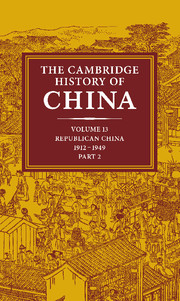Book contents
- Frontmatter
- 1 Introduction: perspectives on modern China's History
- 2 China's international relations 1911–1931
- 3 Nationalist China during the Nanking decade 1927–1937
- 4 The Communist movement 1927–1937
- 5 The agrarian system
- 6 Peasant movements
- 7 The development of local government
- 8 The growth of the academic community 1912–1949
- 9 Literary trends: the road to revolution 1927–1949
- 10 Japanese aggression and China's international position 1931–1949
- 11 Nationalist China during the Sino-Japanese War 1937–1945
- 12 The Chinese Communist movement during the Sino-Japanese War 1937–1945
- 13 The KMT-CCP conflict 1945–1949
- 14 Mao Tse-Tung's thought to 1949
- Bibliographical Essays
- Bibliography
- Conversion table: pinyin to Wade-Giles
- Index
- Republican China - physical features">
- References
12 - The Chinese Communist movement during the Sino-Japanese War 1937–1945
Published online by Cambridge University Press: 28 March 2008
- Frontmatter
- 1 Introduction: perspectives on modern China's History
- 2 China's international relations 1911–1931
- 3 Nationalist China during the Nanking decade 1927–1937
- 4 The Communist movement 1927–1937
- 5 The agrarian system
- 6 Peasant movements
- 7 The development of local government
- 8 The growth of the academic community 1912–1949
- 9 Literary trends: the road to revolution 1927–1949
- 10 Japanese aggression and China's international position 1931–1949
- 11 Nationalist China during the Sino-Japanese War 1937–1945
- 12 The Chinese Communist movement during the Sino-Japanese War 1937–1945
- 13 The KMT-CCP conflict 1945–1949
- 14 Mao Tse-Tung's thought to 1949
- Bibliographical Essays
- Bibliography
- Conversion table: pinyin to Wade-Giles
- Index
- Republican China - physical features">
- References
Summary
Chinese Communist leaders had long seen the war as inevitable because their experience and their ideology convinced them that Japanese expansion in China was fuelled by irreversible forces. ‘The main characteristic of the present situation,’ the CCP reiterated as a litany, ‘is that Japanese imperialism wants to turn China into a colony.’ The CCP also saw the war as necessary and, after the end of 1935, called for unified resistance at the earliest possible moment. Mao and his followers knew that in a Sino-Japanese war they could claim, as patriots, a legitimate, honourable, and self-defined role. Indeed, they intended to claim a leading role in moral terms. For them the only alternative would be a Sino-Japanese peace from which they would surely be excluded and which might be purchased at their expense. Every delay in resistance bought time which the KMT might use to continue campaigns against the CCP. Every delay prolonged the period in which Tokyo and Nanking might come to some further accommodation, possibly including joint anti-Communist action, as Japanese Foreign Minister Hirota had proposed in August 1936.
One need not impugn the CCP's sincerity to note that termination of civil war, a broad united front and resistance to Japan would also serve the party's interest. Its platform matched the mood of urban China – of students, intellectuals, large sections of the bourgeoisie, and many workers – far better than the Kuomintang's repressive call for ‘unification before resistance’. So persuasive did the united front policy become among these groups, and even among some influential factions in the Kuomintang, that it weighed heavily in Chiang Kai-shek's decision, after his release on 25 December 1936, from two weeks' captivity in Sian, to call off the civil war and adopt a stronger posture toward Japan.
Keywords
- Type
- Chapter
- Information
- The Cambridge History of China , pp. 609 - 722Publisher: Cambridge University PressPrint publication year: 1986
References
- 5
- Cited by



